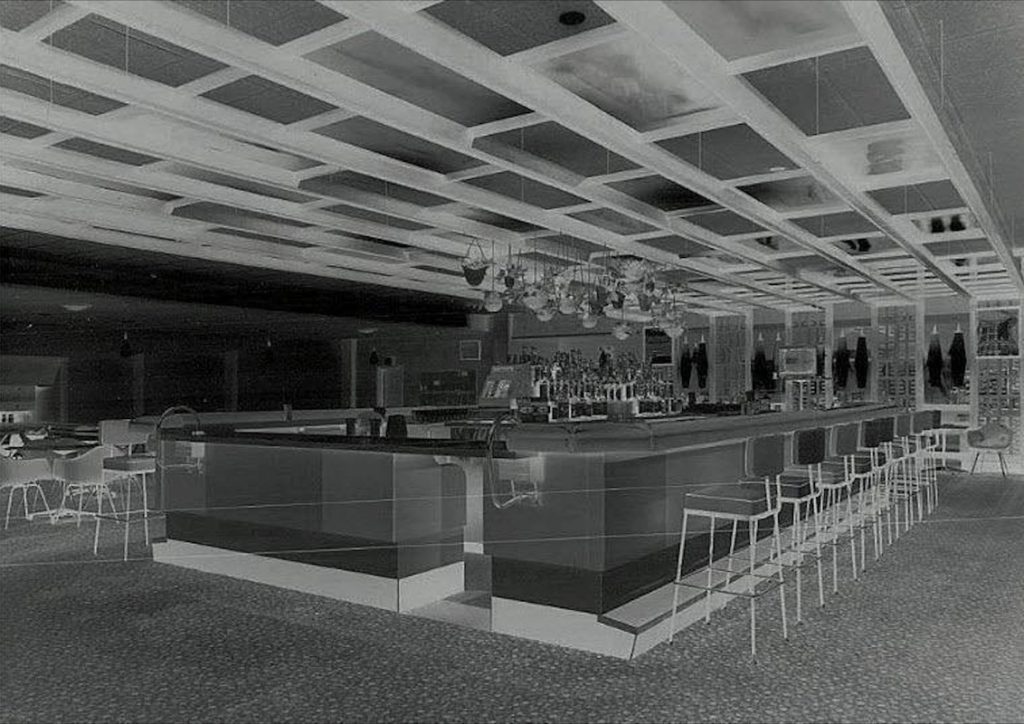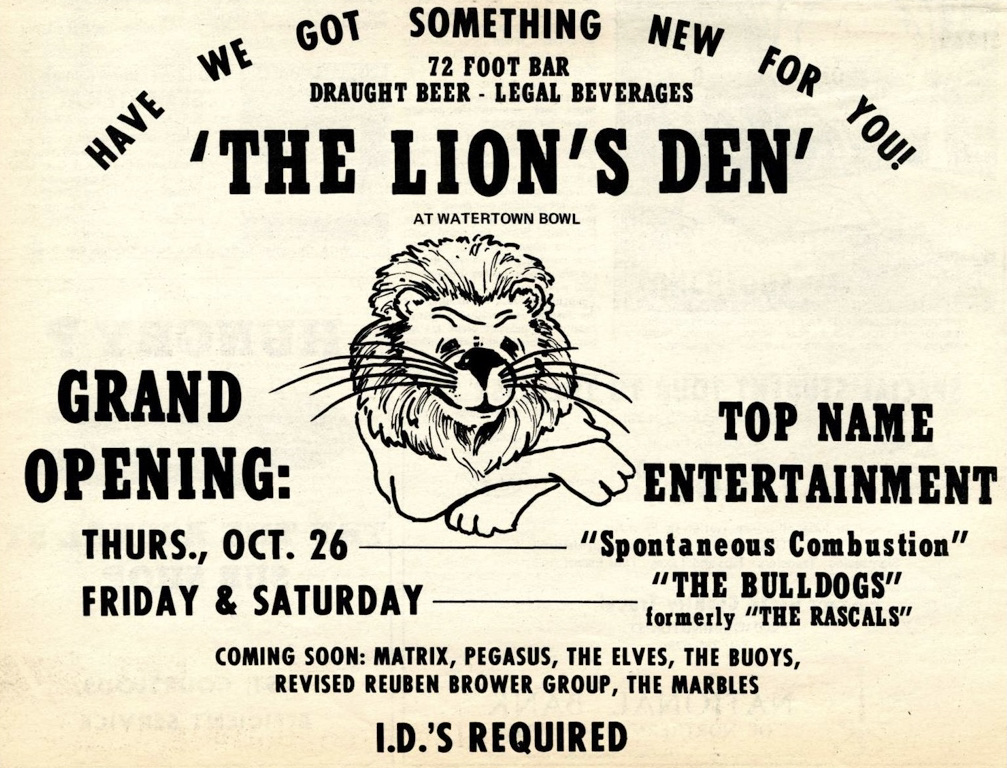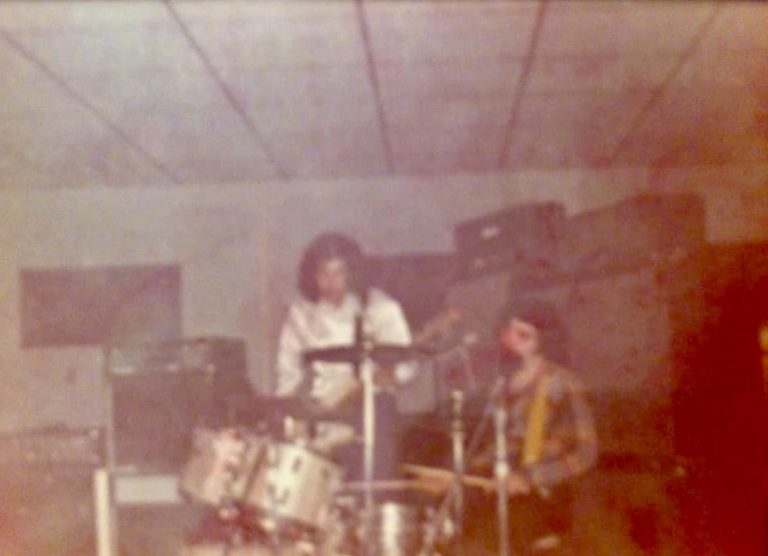The Watertown Bowl And Its Many Clubs Over The Years (1959 – 1996)
In late July of 1958, news would break that Watertown, N.Y. would soon be home to the Watertown Bowl, a $350,000 bowling center to be constructed just outside the city on what is now Route 11, which was referred to as the Watertown-Syracuse highway in that era. The 32-lane establishment would be accompanied by a children’s amusement park, Kiddie Land, to be constructed by Joseph J. Schuler, Sr., of Rochester.

Schuler, head of a bowling corporation with operations in 18 locations throughout the state, would purchase the land from J. J. Capone. The Watertown Bowl, as he planned it, was to include two 16-lane tracts with a snack bar and cocktail lounge between the two tracts and locker rooms in the basement. The Watertown Daily Times would give additional details in their July 26th article–
The dining room will be a full scale operation with table service and the serving of regular meals. The snack bar will be operated on a sandwich basis. The cocktail lounge will also be a full scale operation with bar and table service.
There will also be a nursery in connection with the bowling establishment, where parents can leave their children under direction of trained supervisors, while they are engaging in bowling.
Mr. Schuler noted that construction would begin in the next week to a week and a half on the parcel next to the Starlight Theater, with expectations that the Watertown Bowl would open by November. Unfortunately, that would not be the case. The opening would be delayed until December, then April of the following year, and again until finally opening on May 6, 1959 – and even then, only 16 of the 32 lanes would be ready for use.
A week later, the State Police would order alterations to the building to meet state codes for public assembly. Apparently, the approaches leading into the building were lower than the regular floor and didn’t allow for clearance. The building would remain open during the additional work, but the lounge, snack bar, and dining room would be closed.

Starting in March of 1968, the 34th Annual New York State Woman’s Bowling Championship Tournament would be held at the Watertown Bowl for the next 12 consecutive weekends. Mayor Theodore Rand would get the ball rolling, literally, by bowling a strike to commemorate the start of the highly anticipated tournament, the first of its kind in the area where an estimated 4,000 teams were expected to compete from across the state, bringing as many as 25,000 people to the area. A record number of doubles and singles were also expected to compete.
In 1966, the Watertown Bowl would introduce the “Pendulum Room,” which became home to Discotheque, a fad that swept through the area in the mid-1960s. Places like the New Parrot and Hotel Woodruff would have nightly dancing and Go-Go rooms with girls who often danced in cages. Even local dance academies would offer classes on Discotheque.

Twilight 22 in the 70s
Friday, June 30th, 1978, would see the Watertown Bowl enter the “Twilight 22” zone of the disco era. The Watertown Daily Times would report of the new dance club–
A sensational bombardment of lights, mirrors, black and silver graphic wallpaper, and a lighted, mirror-walled dance floor await the Twilight 22 patron.
The 2,600 lights beneath the dance floor, the 400 lights in the ceiling starbursts and the 300 lights under the bar are computer- controlled by the same console which masters the sound system.
Unfortunately, there would be no need to break out the bell-bottom jeans as Twilight 22 would have a dress code, at least initially. That being said, even if you didn’t have a dance partner, you could dance the Bus Stop or the Roseland Shuffle to your heart’s content all by yourself.
As a harbinger of issues to come in the 1980s, Twilight 22 would introduce Saturday dance lessons to teens. This was another trend that was made popular at the time, but was becoming a gray area necessitating the State Liquor Authority (SLA) sending reminders that teens under the age of 16 needed to be accompanied by a parent or adult guardian, at least 18 years of age, in a place where alcohol was served.
By 1979, Twilight 22 began introducing Senior High Nights and Teen Time on Sundays, where only soda would be served. About a year later, in May of 1980, it appears the club would close without anything printed in the news.
The Max in the 80s
May 29 of 1986 would see the Watertown Bowl advertising “The Max,” a non-alcoholic video dance club where teens could hang out, dance, and socialize, to debut the following day.
It was a time where Salmon Run Mall had yet opened and Fort Drum was undergoing expansion, leaving underaged soldiers and area teens with nowhere to hang out – except Burger King on State Street which would see crowds estimated of 300 gathering . . . and not to watch the Burger King himself in a breakdance battle with Ronald McDonald, either.
The Max was a well-intentioned establishment picking up where Twilight 22 had left off several years prior, but it wouldn’t take long before incidents began piling up in the columns of the Watertown Daily Times. It started with the arrests of two individuals for disorderly conduct, one from Fort Drum, that would eventually plague the club and have parents of teens and teens alike sending in the letters to the editor section on an almost daily basis with Fort Drum soldiers caught in the middle.

The battle between parents and teens would continue well into 1988. The Watertown Daily Times, obviously sensing a hot topic of controversy, would publish an article in their Sunday, April 10th Lifestyles & Leisure front page–
The Max
Hot, Sweaty, Loud: It’s Haven For Teens
Welcome to The Max, that nightclub co-existing with a bowling alley, that den of iniquity and corrupter of youth, that booze-free haven and cultural oasis of youth, that blue-canopied dance palace of the MTV generation on Outer Washington Street where adults fear to, or never even think to, tread.
It’s an interesting contrast of eras: the adults of 1988 with teenagers were teenagers themselves back when Go-Go dancers were in cages and the drinking age was lower.
John Ott, the 37-year-old owner, and his wife, Jennifer, tried to give the younger people an experience without the peer pressure that sometimes comes with alcohol. The Times noted that the average age was 17 or 18, with people coming from Carthage, Lowville, Pulaski, Sandy Creek, Adams, Ogdensburg, and Cape Vincent. Some of the letters written to the editor were from Gouverneur.
Two soldiers interviewed for the article, going by the names “Skywalker” and “Rude Boy,” were regulars each weekend and noted it was the only place to go if you wanted to dance. “All the rest of the places are pretty much live band bars. You’d have to Canada or Syracuse,” Skywalker noted, along with some of their favorite dances including The Slide, The Cabbage Patch, The Wop, and The Push-it. Alas, no live performance was shown for The Bus Stop.
For those with a hazy memory of April 1988, this smash hit reached number one and may have been played at The Max. It looks like an attempt at the Cabbage Patch dance, too.

The Max would continue to be a popular place, but a string of incidents in December may have sealed its fate. By the beginning of January in 1989, The Max was no more. The owners of the Watertown Bowl, now officially the Northland Bowl as of 1987 after being bought by Northland Properties of Oswego, canceled the lease and the last day of operation was New Year’s Eve.
“I don’t like to see people think they have to drink to have fun,” Mr. Ott would tell the Times. He complimented the teens who frequented his club as being the best-behaved group of kids he’d seen in his 15 years of business, but admitted there was the occasional incident or two.
Mr. Ott would later open The Max in Canton, N.Y. under the same premise as a teen nightclub but would eventually give in and make it an establishment that served alcohol. The owners of the Northland Bowl, still referred to as Watertown Bowl by most, would eventually offer a new bar, Barnical Bill’s, in an effort to attract an older crowd with live music shows. It would be short-lived.

In late August of 1990, the owners of Northland Bowl, Northern Properties, would lock the doors to the facility without warning after failing to pay a $7,700 Niagara Mohawk bill. Shortly afterward, the owner of Northern Properties passed away, creating a fiasco that left 700 bowlers scrambling to find new lanes, many of whom had equipment locked in the basement. Per the note above, they wouldn’t be able to access it for well over a month.
Northland Bowl was leasing the property and left the mess for the buildings owner, B&B Properties in Rochester, to handle the mess. Making matters worse, before passing away, the owner of Northland Properties filed for Chapter 11 Bankruptcy in January, leaving behind what the Times reported as “a legal entanglement that includes 111 creditors clamoring for several hundred thousand dollars in debt,” which included $119,854.42 to B&B Properties.
While the facility would re-open as Ridgeview Lanes in 1992, it, too, would be a short-lived effort. It would close in May of 1996, never to reopen as it would be demolished six months later, depriving a new generation of dancing the Macarena on its floor… ¡Ay!

1974 Brings Ronnie Dio and the Elves and Black Sheep to the Lions Den
In 1974, two area lead singers, early in their careers, traveled to the Lion’s Den with their bands to perform. Ronnie James Dio, a native of Cortland, N.Y., was already in his second decade as a musician and had made numerous trips to Watertown, with the band changing names numerous times. He performed as Ronnie Dio and The Prophets at the State Armory, St. Anthony school gym, and the Gaslight at the Seaway Plaza.
His trip to The Lion’s Den in January 1974 came a year before disbanding and joining what was initially known as Ritchie Blackmore’s Rainbow, later known as Rainbow. He later departed the group in 1979 to replace Ozzy Osbourne in Black Sabbath before creating his own heavy metal act, Dio.
Below: Elf with Ronnie James Dio singing “Rainbow” off their 1974 album “L.A./59.”
The same year, Black Sheep was the first American band to sign with Chrysalis, who released their first single, “Stick Around.” The band was fronted by Rochester native Lou Grammatico and toured the local area, including The Lions Den, in December of 1974. After their initial success, Black Sheep signed with Capitol Records and set out to open for KISS when an accident on Christmas Eve 1975 on the New York State Thruway found the band unable to support their album. As a result, they disbanded. Their brief career was not without gains for Lou Grammatico, who met Mick Jones then. Together, the two formed the band “Trigger,” which later became “Foreigner.” That wasn’t the only change; Lou Grammatico became Lou Gramm, and the rest is history.
Below: Black Sheep, fronted by Lou Grammatico, with their first single, “Stick Around.”


















6 Reviews on “Watertown Bowl – Lion's Den – Twilight 22 – The Max – Barnacle Bill's”
Ironically, I was just at Pla-Mor Lanes earlier this week reminiscing about this place. Pla-Mor is still there.
The lions den was the club to be at during the 70s and 80s. Met a very. Nice girl there when I was at Fort Drum for 2 weeks of training every year. Never knew what happened to her after 1984. Hope she made out well.
Brad,
Were you the manager when Channel 10 did broadcasts from the Bowl on Saturdays circa 1972/73?
As my father who first managed the Bowl (Paul Antonelli), at one point in the 70’s the billiard room became a video game room..
I had the privilege of being the General Manager of Watertown Bowl in the mid-70’s.
I worked for Jor Schuler at his flagship bowling center, Olympic Bowl, in Rochester,NY. When Paul Antonelli who was the General Manager left, Joe Schuler moved to Watertown to become the new GM.
When I was first there the billiard lounge was starting loose its popularity and it was eveident the space could be used differenlty. It was then that the Lion’s Den was created. It boasted an 80 foot bar that was constructed out of bowling lane wood. It was a large room with a stage for live bands. It quickly became a very popular place with live bands form all over the country. Watertown Bowl was a busy bowing center with double shifted league bowling. tournaments.
Just prior to the Lion’s Den opening, Joe Schuler entered inhto a management lease with Bruncwick of all of his 10 bowling centers. I was then hoired by Brunswick to continue as GM. Within a couple of years Brunswick moved me back to Rochester to become the GM of Olympic Bowl their 80 lane bowing center. Watertown Bowl was a primier bowling center for many years and there were many wonderful and dedicated employess who worked there as well as a great customer base. Many great memories! Brad Smith former General Manager.
Thanks for providing some additional information! I hope nobody tried to bowl at the bar using empty bottles as pins!
prior to the Lion’s Den, the facility was a Brunswick Billiard Room. I remember stopping after high school to play a few games of pool before going home